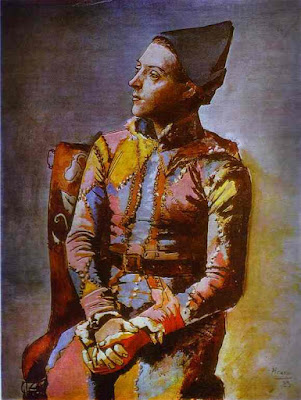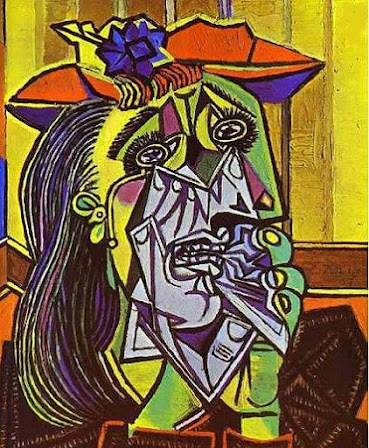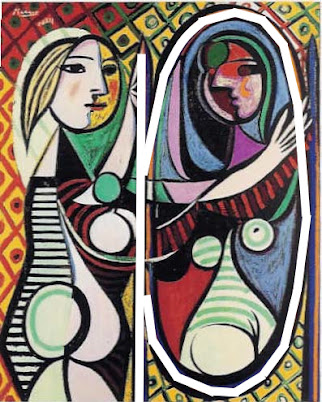Pablo Picasso (Oct. 25, 1881–1973) was the most influential artist of the 20th century.
Across eight decades and countless media, he pursued new modes of representation
in a career characterized by ceaseless change and experiment.
Born in Málaga, Spain, Picasso studied in Barcelona and Madrid before settling in Paris. His early manner—marked by the influence of Henri de Toulouse-Lautrec and the bohemian milieu of Montmartre—was swiftly supplanted by the melancholy palette and gaunt figures that define the work of his so-called Blue Period (1901–1904).
"The Old Guitarist" 1904 Blue Period
Picasso was a poor student in a city where he did not speak the language.
He lived in a tiny, poor, cold apartment. This blind man sat in the doorway
of his apartment building and played the guitar for handouts.
"Boy with a Pipe" Rose Period
A new lyricism and interest in Classical tradition emerged in the Rose Period (1904–1906), which, in turn, gave way to the fractured geometry and assertively painted surfaces that defined Cubism in its various forms.
"His Son Paul as Harlequin"
Notice the contrast between the modeling of Paul's face
and the flatness of his costume and chair.
"First Wife Olga Koklova." She was a Russian ballerina.
The portrait is a combination of traditional realism and superb
draughtsmanship in her face and arms and dress and the utter
flatness of the needlepoint pattern on the armchair.
Picasso’s co-creation (with Georges Braque) of this radical new approach to representation was his most significant contribution to the history of Western art and ways of seeing. Cubist paintings, prints, and sculptures are not fully abstract—that is, they are not entirely divorced from the observed world. They do, however, trouble the relationship between the object and its image, rejecting likeness as the defining feature of visual representation.
"Portrait of Gertrude Stein."
Stein was an American living in Paris with her partner, Alice B. Toklas.
Stein was one of the first people to recognize, accept, and praise
Picasso's work. She had an apartment where writers, musicians, and
artists came together for a free meal and to talk about their work.
Picasso made this painting as a gift for Gertrude, and it hung on her wall
where everyone could see it.
"Girl with a Mandolin."
And then Picasso began his experiments in depicting space,
volume, and objects in space. He was no longer interested in
the infinite space beyond a Raphael madonna. Picasso reduced
all his subjects to flat planes then broke them, like shards of
glass, and rearranged them. In this phases of Cubism, he
cold not deal with color also, and so it is called
"Analytical Cubism."
"Still Life with Chair Caning."
He abandoned the human figure completely to concentrate upon a few simple forms
in a still-life. And he made the reality/art dichotomy even more complex by taking
the actual seat of a cafe chair, covering it with a piece of oil cloth meant to look
like caning, and then painting over it. The newspaper ("Journal') is folded, the espresso
cup round.
"Guitar"
And then Picasso broke away from 2 D completely and tried 3 D
and sculpture. In the whole history of the world, all sculpture had been made
by casting (bronze or iron) or carving (wood or stone). Picasso wondered why?
He began assembling sculpture of found pieces of wood or wire or metal.
"The Three Musicians" 1921
And then Picasso broke forth into full Synthetic Cubism with forms
flattened, broken apart and reassembled from multiple viewpoints, and
brilliant flat color. Most artists date their work with a year indicated;
Picasso worked so feverishly, he had to record the hour and day as well.
There are several versions of this work with the three figures in
different positions.
"Weeping Woman." 1932
Has the image of a shattered woman ever been more powerfully recorded?
This is Dora Maar, his mistress, whom he did not treat well, but who served
as his model for years.
Although the properly Cubist phases of Picasso’s stylistic development lasted only to the end of World War I (when he, like many of his colleagues, participated in a widespread conservative turn known as the rappel à l’ordre), the great Cubist experiment would influence his work for the rest of his life.
"Le Reve / The Dream." 1937
This is actually a portrait of his mistress, the German girl and
housekeeper, Marie-Therese Walter. She was blond and had a round
full figure. As she modeled long hours for Picasso, she sometimes
fell asleep, as she has here on the red armchair. Picasso did many
versions of this subject.
"Woman with a Book" is another version of Marie-Therese in the red
armchair and here wearing a Roumanian blouse with flowery sleeves.
This is in the Norton Simon Museum in Pasadena.
"Girl in Front of Mirror"
Here Marie-Therese stands before a mirror and we can see her image
repeated, distorted, reflected in many ways.
Women played a very important role in Picasso's life. Each new woman brought a change in his art and view on life. His first wife was the Russian ballerina, Olga Koklova. The young German housekeeper, Marie-Therese Walter, was his love and his great muse with her blond hair and rounded forms. Dora Maar was the model for "Woman Weeping." Jacqueline Roque was a long-time companion and model, and Francoise Gilot, who later married Jonas Salk. There were more than twenty of them.
"Guernica" 1937
Picasso was in France during the horrible Spanish Civil War which raged in the 1930s
and killed hundreds of thousands innocent young men and civilians. This is perhaps
the greatest anti-war statement ever made. He had been using images of bulls and horses
and now included them. Flames engulf villages, men are killed and women raped, children
slaughtered like animals and mothers crying out in utter horror.
Today, we have all seen the videos from Vietnam and the World Trade Center.
We know what violence does to human bodies. The man has been shattered,
torn apart, his eyes ripped out, the mother holds her dead child.
"The Dove of Peace" by Picasso
Picasso left more than 15,000 works of art when he died. These were eventually catalogued by the state for tax purposes. He would fill a house with his work and then leave it and buy a new house, which he would fill with new art.
__


















No comments:
Post a Comment